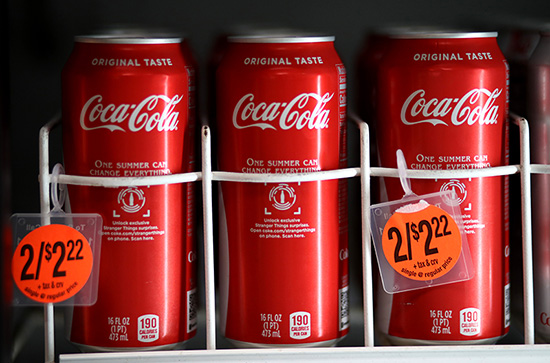百年老店專注夕陽產(chǎn)業(yè),卻受到投資者熱捧,原因在于中國

|
這家公司度過了狂歡的一年。 Ball Corp.最近擊敗了經(jīng)常霸榜的生物科技公司和科技公司,成為過去12個月內(nèi)標普500指數(shù)中表現(xiàn)第二好的股票,而大多數(shù)消費者對這家公司的了解都是通過它曾經(jīng)銷售的Ball牌梅森杯間接獲得的。 該公司已經(jīng)有將近一個半世紀的歷史了,它很早就加入了反對塑料的戰(zhàn)爭,現(xiàn)在控制著全球33%的金屬罐市場份額。如今,敏感的市場情緒以及所謂健康飲料的繁榮讓該公司從中受益。它在20世紀90年代剝離了水杯生產(chǎn)業(yè)務(wù),現(xiàn)在鋁包裝業(yè)務(wù)是重中之重。 標普500指數(shù)過去12個月的回報率只有區(qū)區(qū)2%(原因之一是國際環(huán)境的變化),但Ball Corp.的股價卻飆升了91%。 這家市值250億美元的公司為百威英博啤酒集團(Anheuser-Busch InBev)和可口可樂(Coca Cola)等公司供貨,過去12個月的投資回報率僅次于債券交易平臺MarketAxess。 幾年來,消費者出于對健康的擔憂,對汽水和啤酒的需求一直在下降,這兩種產(chǎn)品是飲料罐行業(yè)的存亡關(guān)鍵,因此拖累了Ball的股價。但尼爾森的數(shù)據(jù)顯示,蘇打水、即飲雞尾酒和其他種類的飲料已經(jīng)取而代之,2018年飲料銷售額增長3%,達到560億美元。 Ball公司 116億美元的收入中約90%來自于飲料包裝(另外10%來自于該公司的航空航天部門)。 “如果你在1986年走進一家便利店,貨架上的瓶瓶罐罐可能會有不同的顏色。”研究公司Vertical Research Partners的合伙人奇普·狄龍說,“市面上有這么多飲料品牌,要讓人們注意到你,你需要生產(chǎn)很多不同的尺寸和形狀。第二,塑料已經(jīng)變成了眾矢之的,而最便宜的替代品是鋁。” 以Liquid Death為例。今年5月,該公司在種子輪籌集了160萬美元的資金,銷售的罐裝水不僅以滑稽的“硬核”形象出現(xiàn),而且還強調(diào)金屬比塑料更可持續(xù)。飲料罐上除了印著“殺死口渴”這樣吸引眼球的口號,還印了“塑料終結(jié)者”的話題標簽。標簽上說,70%的鋁罐是可回收的,可回收塑料瓶只有3%。 塑料戰(zhàn)爭 在2019年索恩投資大會上(Sohn Investment Conference),資本公司Diameter Capital Partners的斯科特·古德溫表示,他正在做空Plastipak的無擔保債券。Plastipak是一家為卡夫亨氏(Kraft Heinz)和寶潔(Proctor & Gamble)等公司提供硬質(zhì)塑料包裝的公司。 “塑料包裝行業(yè)已經(jīng)日薄西山。”他在今年5月表示。 早在很久之前,倡導(dǎo)者就開始警告消費者,塑料制品在海灘上堆積如山,但是,反對塑料制品的運動,特別是反對單一用途塑料制品的運動,卻在今年的美國市場上掀起了軒然大波。 洛杉磯和溫哥華等城市正在禁止或限制塑料吸管的使用,而星巴克、凱悅和希爾頓等大公司則計劃縮減對塑料的使用。百事可樂表示,計劃將阿夸菲納(Aquafina)品牌的水裝在鋁罐里。過去,中國是回收世界上大量垃圾的垃圾場,卻在2018年停止了此類進口,美國國內(nèi)因此引發(fā)了一場垃圾危機。 投資者看到市場對塑料制品的抵制,因此押注于Ball的可持續(xù)發(fā)展。 Robert W. Baird & Co. Senior Research研究公司的高級研究分析師甘沙姆·潘賈比稱:“過去幾年,人們對氣泡飲料、能量飲料和可持續(xù)的關(guān)注推動了(對飲料罐的)需求。” 這家鋁罐制造商也投入了雙倍賭注。為了解決目前每一間大學(xué)校園或戶外場地都存在的一次性杯子問題,該公司計劃推出可重復(fù)使用的鋁杯。 摩根士丹利(Morgan Stanley)的分析師尼爾·庫馬爾在最近給投資者的一份報告中寫道:“鑒于全球?qū)σ淮涡运芰现破返膶彶槿找鎳栏瘢覀冋J為鋁杯(全球鋁杯的潛在市場約為900億件,美國約為300億件)對Ball來說是一個重大的長期的機遇。” 這種勢頭還能繼續(xù)嗎? 從一種衡量標準來看,該股的市盈率為47倍,不便宜。2018年,這個數(shù)字是27。“這是一種趨勢。” Vantagepoint Investment Advisers公司的首席投資官韋恩·威克指出,“該股是否容易受到回調(diào)的影響?這不是不可能的。” 此外,該股的上漲也不能完全歸因于公司本身。對經(jīng)濟衰退的擔憂也促使投資者更多地買入Ball等防御類股,這些股票的特點是增長穩(wěn)定,波動性較低。標普500主要消費指數(shù)過去一年上漲了12%,該股指包括寶潔、可口可樂、百事可樂和沃爾瑪?shù)裙尽?/p> 威克補充稱:“地緣政治和對關(guān)稅的擔憂帶來了更大的不確定性,其中許多因素給投資者對未來收益增長的預(yù)期蒙上了陰影。” 但就目前而言,看多情緒一直在推動Ball的股價上漲。(財富中文網(wǎng)) 譯者:Agatha |
It’s had an absolute ball of a year. Ball Corp.—a company that most consumers only know obliquely through the Ball-branded mason jars it once sold, beat out biosciences and tech companies that have often dominated the rankings recently to become the second best performing stock on the S&P 500 index over the past 12 months. Nearly a century-and-a-half old, Ball enter the war against plastic early, and now controls about 33% of the global market share for metal cans. And now, that, combined with jittery markets and a boom in so-called healthier beverage choices have benefitted the company, which spun off its jar business in the 1990s and now runs an aluminum packaging business as its crown jewel. While the S&P 500 index returned a paltry 2% over the past 12 months in part due to escalating trade war tensions, shares of Ball Corp. have soared 91%. The $25 billion company by market capitalization, that serves the likes of Anheuser-Busch InBev and Coca Cola, ranks just behind MarketAxess, a bond trading platform, in terms of returns over the past 12 months. For several years, consumer demand for the bread and butter of the industry—soda and beer—had been declining due to health concerns and dragged on the Ball’s shares. But seltzers, ready-to-drink-cocktails and other options have taken their place, boosting beverage sales 3% to $56 billion in 2018, per Nielsen’s data. Roughly 90% of Ball’s $11.6 billion revenue comes from beverage packaging (the other 10% comes from the company's aerospace unit). “If you went into a convenience store in 1986, the bottles and cans maybe had different colors,” said Chip Dillon, a partner at Vertical Research Partners. “With the number of beverage brands out there, to get people to notice you, you need many different sizes and shapes. Number two, plastics have become the bad guys—and the cheapest alternative to plastic is aluminum.” Take Liquid Death for example. In May, the company raised $1.6 million in seed funding and sells canned water branded not only to appear comically “hardcore,” but also to emphasize how metal is more sustainable than plastic. Alongside the catch phrase “murder your thirst,” the can also features the hashtag, “DeathToPlastic.” While 70% of an aluminum can is recyclable, the label claims, just 3% of a plastic bottle are. War on plastic At the 2019 Sohn Investment Conference, Diameter Capital Partners’ Scott Goodwin said he’s shorting the unsecured bonds of Plastipak, a company that provides rigid plastic packaging to the likes of Kraft Heinz and Proctor & Gamble. “The sun is setting on the age of plastic packaging,” he said in May. Advocates have long warned consumers of plastic build up in beaches—but the movement against plastic, especially of the single-use variety, hit the U.S. market full force this year. Cities including Los Angeles and Vancouver are in the process of banning or restricting the use of plastic straws, while major companies including Starbucks, Hyatt, and Hilton plan to shrink their plastic footprint. Pepsi said it plans to serve Aquafina-brand water in aluminum cans. China, which was the dumping ground for much of the world’s recycling in the past, ended such imports in 2018 and, in the process, created a trash crisis stateside. Seeing a pushback against plastic, Ball has been a bet on sustainability for some investors. “In the last couple years, (demand for cans) has been propagated by interest in sparkling, energy drinks, and sustainability concerns,” said Robert W. Baird & Co. Senior Research Analyst Ghansham Panjabi. The can maker is also doubling down. In an answer to red solo cups now native to any college campus or cookout, the company plans to release reusable aluminum cups. “Given the increasing global scrutiny on single serve plastics, we believe aluminum cups (addressable market of about 90 billion units globally, about 30 billion units U.S.) represent a substantial long term opportunity for Ball,” wrote Morgan Stanley analyst Neel Kumar in a recent note to investors. Can the run continue? By one measure, the stock is expensive with a price-to-earnings ratio is at a 47 times earnings. In 2018, that figure was 27. “That is a run,” notes Wayne Wicker, Chief Investment Officer with Vantagepoint Investment Advisers. “Is the stock vulnerable to a pull back? It’s not outside the realm of possibility.” Moreover, the stock’s rise can’t entirely be attributed to the company. Recession fears have also pushed investors into defensives stocks like Ball, that feature steady growth and low volatility. The S&P 500 Consumer Staples Index, which includes the likes of Procter & Gamble, Coca-Cola, Pepsi, and Walmart, has risen 12% in the past year. “There’s been greater uncertainty with some geopolitical and tariff concerns, many of those things clouded investors outlooks in terms of future earnings growth,” added Wicker. But for now, the bulls have kept the Ball rolling. |













